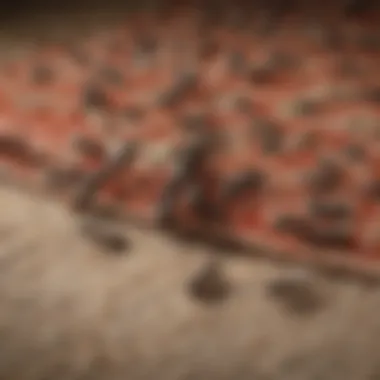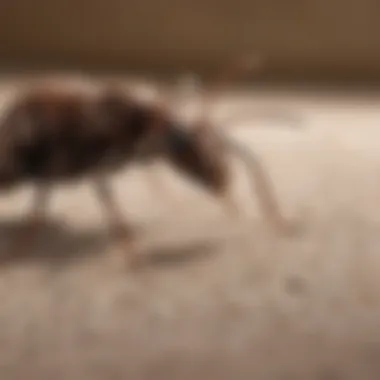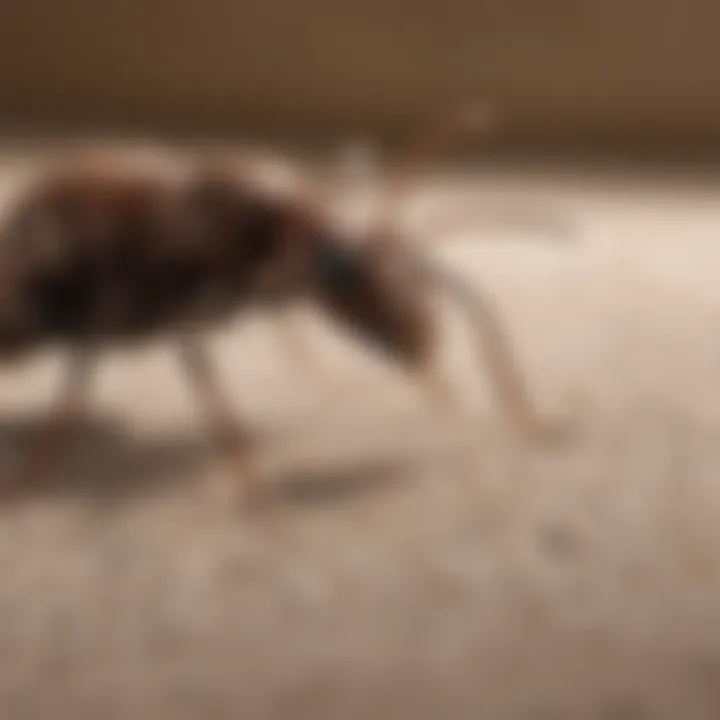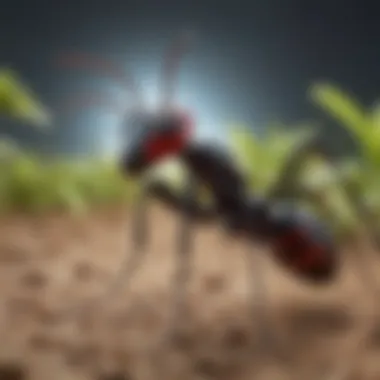Effective Strategies for Ant Removal in Carpets


Intro
Dealing with ants in carpeted spaces can feel like a never-ending battle. You might spot a lone soldier marching aimlessly across your living room floor, and before you know it, you've got a small army invading your fabric floors. This article dives deep into understanding these pests, prevention techniques, and eco-friendly solutions for managing ant infestations effectively.
It's like playing whack-a-mole; as you think you’ve beaten them back, they find another way to invade your home. Understanding how they operate and the effective strategies to combat them is essential for maintaining a clean and comfortable environment.
Understanding Pests
Definition of Pests
Pests are generally defined as organisms that cause damage or disturb ecological balance when introduced to an environment where they are not native or intended. Ants fall squarely within this category, marching in to munch on your food, invade your living spaces, and snag a spot on your wool carpets.
Importance of Pest Identification
Identifying the specific type of ant you've got is crucial. You might be dealing with fire ants, carpenter ants, or even the notorious sugar ant. Each species has its own behavior patterns and preferred baits. Not only will knowing what you’re up against shape your approach, but it also helps you pinpoint their nest locations.
"Understanding the enemy is the first step in winning the battle."
Knowing whether they are after crumbs in the kitchen or the woodwork in your walls can make a world of difference.
Prevention Techniques
Home and Garden Preventative Measures
Prevention starts at home. Maintaining cleanliness in your kitchen and dining area is of utmost importance. Using these strategies can help keep the pesky ants from establishing a foothold:
- Seal entry points: Cracks and crevices in walls and foundations are prime entries for ants. Caulk and seal these gaps.
- Store food properly: Keep food in airtight containers. Even small crumbs can attract ants, so wipe surfaces regularly.
- Remove standing water: Ants need water to survive. Fix leaks and eliminate standing water in your home.
Seasonal Prevention Tips
Ant behavior often changes with the seasons. Be aware of these seasonal shifts:
- Spring: Queens start to emerge in search of food for their colonies. Ensure that outdoor food sources are cleaned up.
- Summer: Ants are more active and can be found searching for food outdoors. Maintain your landscape, trimming back bushes and loading up compost bins securely.
- Fall: Ants may invade seeking warmth. Seal up your house and check for any nesting sites near your home.
Eco-Friendly Pest Control Solutions
Overview of Sustainable Practices
Taking an eco-friendly route to pest control doesn't only benefit the environment; it's often safer for you and your family. Consider practices like using natural barriers and non-toxic traps, or even allowing certain plants that naturally repel ants, such as mint and garlic, to thrive in your garden.
Natural Remedies and Their Effectiveness
Many homeowners are turning to natural remedies to combat ants. Some effective options include:
- Vinegar solution: Mix equal parts vinegar and water and spray it where you spot ant trails. Ants dislike the smell and will steer clear.
- Cinnamon: This aromatic spice is known for its repellent properties. Sprinkling it around infested areas can deter these uninvited guests.
- Diatomaceous earth: This powdery substance can be sprinkled where ants tread. It’s harmless to pets but lethal to bugs, drying them out when they come into contact.
With a little diligence and some natural remedies, you can reclaim your home from these tiny invaders. Ant infestations can feel overwhelming, yet knowing the right steps to take can make all the difference.
Understanding Ant Behavior
Ants are not just common nuisances; they are complex creatures with well-defined behaviors. Understanding how they think and operate can significantly assist in devising effective eradication strategies. By examining their habits, motivations, and social structures, homeowners can gain insights that guide their pest control methods. Knowing why ants invade a space can lead to tailored approaches that disrupt their pathways and colonies.
Types of Ants Commonly Found Indoors
Indoors, the most prevalent species include the carpenter ant, odorous house ant, and pharaoh ant. Each has its unique traits. Carpenter ants, for instance, are notorious for nesting in wood, causing structural damage over time. Odorous house ants emit a smell akin to rotten coconut when crushed, and tend to invade homes for food. Pharaoh ants are tiny and can reproduce quickly, making them a formidable adversary. Identifying the type of ant is crucial, as different species respond to treatments in various ways.
Reasons for Ant Infestations
Food Sources
Ants are opportunistic feeders. They tend to gravitate towards easily accessible food sources, especially sugar and protein. If there's a crumb on the carpet or an unsealed container in the cupboard, you've just rolled out the red carpet for them. Understanding this behavior helps in thwarting them right at the source, before they turn your cozy home into a buffet.
Nesting Habits
Nesting can occur anywhere that's dark and moist, from within walls to under floorboards. Understanding where they build nests is very important. Carpenter ants, for example, prefer wood, particularly if it’s damp or decaying. This insight allows homeowners to identify high-risk areas and take preventative actions, such as addressing leaks or maintaining structural integrity.
Seasonal Influences
The time of the year can drastically affect ant behavior. During warmer months, ant activity spikes as colonies expand. In colder months, they might seek shelter inside homes. Recognizing these patterns can prepare homeowners to increase vigilance during peak seasons. Understanding when ants are most active is useful in planning cleanup or treatment sessions, ultimately saving effort and time.
Ants and Their Life Cycle
Ants undergo a fascinating life cycle consisting of several stages, each an essential part of their development. By learning about these stages, homeowners can disrupt their reproductive cycle, thus preventing future issues.
Egg Stage
The egg stage is crucial to the ant life cycle. A queen lays hundreds of eggs, ensuring the colony's future. Knowing how long eggs take to hatch can help homeowners anticipate an influx of ants soon after detecting their presence. Early detection of these eggs can provide a chance to nip the problem in the bud before it festers.
Larval Development
Once the eggs hatch, they enter the larval stage, where they rely on worker ants for food. The larval stage varies in duration depending on the species and environmental conditions. Effectively eliminating food sources can impact the larval stage by starving out the next generation of ants. This stage can be targeted by ensuring cleanliness and proper food storage, cutting off access to these nurturing worker ants.
Adult Ants
Adult ants are the visible members of the colony and can live for several years. Their presence indicates a well-established colony nearby. Knowing how to effectively handle adult ants, especially through baiting and targeted insecticides, can break the cycle of infestation. It's these adult ants that carry food back to the nest, so controlling their movement is key to dealing with an infestation.
Identifying Infested Areas
Identifying infested areas is critical in developing a focused strategy to combat ant invasions. Recognizing the signs and locations that attract these tiny invaders sets the groundwork for effective treatment. Homeowners often find themselves lost in the sheer number of possible entry points and nesting sites within their homes, making it vital to narrow down specific areas of concern. By pinpointing infested locations, you not only gain clarity on the severity of the problem, but you also save time and resources during the treatment process.
This section will dive into distinct signs of ant presence and areas that may be contributing to their infestation, giving you the necessary insights to tackle the problem head-on.
Signs of Ant Presence
Visible Trails
Visible trails are perhaps the clearest indication of an ant presence in your home. Ants communicate and navigate by leaving pheromone trails, allowing them to find food sources more efficiently. When you observe a line of ants marching in a brigade, it showcases not just their presence but also hints at their intended destination.
One key characteristic of visible trails is consistency. Ants typically follow the same routes, making these trails a beneficial starting point for tracking back to their nests. This uniqueness provides a direct line to where you might focus your eradication efforts. On the downside, trails can sometimes lead to misidentifying the colony's source, requiring patience to ensure you are targeting the correct location.
"Where there are ants, there is a pathway back to their source."
Dropped Exoskeletons


Ants shed their exoskeletons as they mature, and finding these discarded shells is another telltale sign of an infestation. Dropped exoskeletons can indicate a possible ant colony nearby, showing that your home harbors more than just a few wanderers.
A significant feature of these exoskeletons is their durability; they can linger for quite some time, even after the ants have vacated. Their presence is a clear reminder that some level of activity has occurred in the space. However, while their discovery is informative, it can also be misleading, as one might misinterpret the signs with non-infested areas.
Nesting Sites
Understanding nesting sites takes your ant detection a step further. Ant nests can be hidden in carpets, walls, or within smaller gaps and crevices in your home. Identifying these nests is crucial since they harbor not only adult ants but also their young.
The unique characteristic of nesting sites lies in their proximity to resources like food or moisture. Ants usually select these areas to create secure environments for development. Locating a nest can ultimately guide your treatment strategy, giving you a clear target. However, nests might be tricky to find, as they can exist in places that remain out of sight, complicating eradication efforts.
Spotting Areas of Attraction
Food Storage Areas
Food storage areas are like a buffet for ants. Anything from uncovered food items to pantry spills can draw ants in, often leading them to find their way onto carpets nearby. Highlighting the significance of these areas is their easy accessibility; if food is left out, ants won’t hesitate to take advantage of it.
One unique feature about these areas is that they reveal not just where ants come from, but also help identify what types of food attract them. Yet, it’s essential to consider that not all food sources will invite the same ant varieties, which might complicate targeted treatments.
Moisture Zones
Moisture zones in your home can create a cozy environment for ants. Areas like under sinks, around bathrooms, and any water leaks provide ideal conditions for nest formation as well as hydration. The key feature here is that ants do not only seek food; they also look for water.
Moreover, moisture zones have the added drawback of supporting other pests, leading to a cumulative infestation. Finding these zones often requires direct inspections, as water damage can be hidden behind walls or beneath flooring.
Entry Points
Recognizing entry points is paramount in thwarting ant invasions before they take root. These points include cracks in walls, gaps in windows, and door seals that may not be tight. One noteworthy aspect of entry points is their ubiquity; ants are inherently small creatures, which means they can exploit even the tiniest openings to breach your home.
This feature highlights the preventative aspect of addressing entry points early in the process. While sealing entry points is crucial, one must also consider the potential for ongoing inspections to avoid new access ways.
Identifying infested areas encompasses an array of factors, from spotting direct signs of ant presence to understanding what attracts them in the first place. This knowledge lays a strong foundation for the subsequent steps in combating situations involving ants.
Preparation for Treatment
Preparing for treatment is crucial in effectively dealin with ant infestations in your carpets. This phase is where strategy meets action. Identifying the severity of the problem and gathering the right tools makes a significant difference. Without adequate preparation, you might as well be throwin' darts in the dark. The main points to consider are ensuring you have a clear understanding of how widespread the infestation is and having your cleaning supplies and control methods ready at hand.
Assessing the Severity of Infestation
Understanding the severity of the infestation helps homeowners tailor their approaches effectively. It sets the groundwork for successful eradication and future prevention.
Extent of Spread
Assessing the extent of spread involves takin' a good look around your home to see just how far the ants have made themselves at home. Are there just a few stragglers, or have they taken over? This is a key aspect because it informs how aggressive your treatment plan needs to be. If the ants seem to be havin' a party in multiple rooms, that’s a red flag. The benefit of recognizing this early is that you can implement a comprehensive action plan instead of playing whack-a-mole with the ants.
One unique feature of identifying the spread is the use of trails. Ants often leave a pheromone trail to guide their buddies to resources. The advantage here is that persistent trails can show you where they’re comin' from and where they’re headin'. On the flip side, some varieties of ants camouflage well, making it tricky to spot them right away.
Frequency of Ant Sightings
Now, let's talk about how often you’re seein' these little pests. Frequent sightings are often a sign of a more serious issue. If you find yourself spotin' ants regularly, it's likely that you're dealing with a larger colony that has set up shop close by. A key characteristic to consider is whether you see individual ants or large groups. Many ants moving together can indicate they’re on the hunt for food or are either coming from or going to their nest.
To note, higher frequency of sightings means faster action is needed. The unique feature here is how quickly ant colonies reproduce. Ignoring these signs can lead to a full-blown invasion in no time. However, not all sightings mean an infestation; some may just be lone scouts, so context matters.
Gathering Necessary Tools
Once you have a grip on the situation, it's time to gather your tools. Having the right supplies is half the battle. You don't want to run around like a chicken with its head cut off when the moment comes to tackle those ants.
Cleaning Agents
Cleaning agents play a strong role in the combat. Options like vinegar or dish soap can disrupt ant trails and remove anything that might be attracting them. Their effectiveness comes from stripping scents ants rely on to navigate your home. What sets them apart is their accessibility; you likely have them already at home. However, the downside is that cleaning alone might not eradicate the root problem.
Traps
Traps can be a game-changer in pest control. They’re direct and can capture ants on the spot, offering immediate feedback on your infestation severity. There are different types of traps like sticky traps or baited traps. Sticky traps catch ants when they wander over, while baited traps lure them in with food.
One disadvantage is that traps usually only kill a handful of ants at a time, and can’t address the queen or her brood directly. However, they can help monitor the situation as well, making them a useful part of your toolkit.
Baits
Ant baits are another powerful tool at your disposal. They serve food to the foraging ants and send them back to the colony with a dose of poison mixed in. This not only takes care of the adults that eat it but potentially affects the queen and her brood. The appeal of baits is significant—ants take the bait voluntarily, which can make them more effective than direct sprays or other methods.
However, it requires time. You might not see immediate results, which can be frustrating. But persistence pays off as the bait works its way through the colony.
In sum, preparation is vital in tackling ant problems effectively. Knowing the severity and having the right tools leads to better strategies.
Effective preparation sets the stage for all subsequent actions in the task of eradicating these little invaders. From the extent of spread to frequency of sightings to gathering the correct cleaning agents, traps, and baits, this groundwork is what makes all the difference in successful pest control.
Cleaning and Preparing the Carpet
Cleaning and preparing the carpet plays a vital role in effectively combating ant infestations in your home. Ants thrive in cluttered, dirty environments where they can easily find food and establish nests. By ensuring that your carpets are clean and well-maintained, you create an inhospitable environment for these unwelcome guests, making your efforts in pest management much more effective.
Thorough cleaning not only removes food particles and debris that attract ants but also helps to uncover any hidden nests or trails that ants may be using. A clean carpet can serve as your first line of defense against infestations. It also contributes to the overall hygiene of your home, which is a great plus for your family’s health.
Thorough Cleaning Techniques
Vacuuming
Vacuuming is often the first step in the battle against ants. It’s not just about aesthetics; it’s about getting rid of the crumbs that can lure ants to your carpets. The act of vacuuming can immediately reduce visible ant populations by physically removing them, along with their eggs. This method is accessible to many homeowners, requiring little more than a vacuum cleaner and a bit of time.
- Key Characteristic: Regular vacuuming creates a proactive approach to pest control. It’s a simple habit that can yield significant benefits.
- Advantage: Vacuuming is quick and effective, particularly when combined with emptying the vacuum bag or chamber afterward to prevent ants from escaping back into your home.
- Disadvantage: While helpful, vacuuming may not eliminate small, hidden nests, as it primarily addresses what is visible on the surface.
Shampooing
Shampooing carpets goes a step further than vacuuming. This process not only cleans but also sanitizes the fibers, tackling dirt and odors that may attract ants. Special carpet shampoos can be used to enhance cleaning power.
- Key Characteristic: Shampooing provides a deeper clean that reaches into the fibers and padding of the carpet.
- Advantage: It can remove stubborn residues that vacuuming alone might miss, which is essential in disrupting potential ant food sources.
- Disadvantage: The main drawback is that shampooing can be a labor-intensive process and may require drying time, during which ants could return if not properly managed.
Steam Cleaning
Steam cleaning is touted for its ability to disinfect and remove allergens. For ant infestations, the high temperatures involved can kill ants on contact and help dislodge eggs from the carpet fibers.
- Key Characteristic: This method utilizes heat and moisture, providing a two-fold advantage in pest management.
- Advantage: Steam cleaning is highly effective at eliminating a wide range of pests and their biological materials, offering a deeper clean without harsh chemicals.
- Disadvantage: Of course, steam cleaners can be expensive to rent or purchase, and the process may temporarily saturate the carpet, leading to longer drying times compared to other methods.
Removing Food Sources


Proper Food Storage
Proper food storage is crucial when it comes to combatting ant infestations. Storing food in airtight containers drastically reduces the food sources that attract ants.
- Key Characteristic: Securing food effectively limits the accessibility ants have to their primary lure.
- Advantage: This practice not only deters ants but also ensures that your food remains fresh and uncontaminated.
- Disadvantage: It may require an initial investment in good storage containers and a shift in habits for some households.
Regular Cleaning
Regular cleaning goes beyond merely dealing with crumbs; it also includes maintaining a clutter-free environment and routinely checking spaces where food might be left out or spilled.
- Key Characteristic: Regular cleaning creates a habit that significantly reduces the likelihood of infestations.
- Advantage: It promotes a sense of cleanliness and order, making your space look inviting while minimizing ant risks.
- Disadvantage: It demands consistent effort and commitment from all members of the household, which can be challenging for some families.
By adopting these cleaning methodologies and food management strategies, homeowners can take significant strides toward eradicating and preventing ant infestations in their carpeted spaces.
Chemical Control Methods
Chemical control methods are crucial in tackling insect infestations, especially in carpeted areas where ants tend to establish their nests. These methods involve the use of various insecticides designed to eliminate ant colonies effectively. While natural remedies have their place, employing chemical solutions often results in a faster and more thorough eradication of these pests, ensuring a cleaner and healthier home environment.
In pest control, chemical solutions come with specific benefits, such as rapid action and targeted effectiveness. However, they also require careful consideration regarding safety and proper application to minimize any potential hazards to humans and pets.
Types of Insecticides
Sprays
Sprays are a favored choice for many homeowners because they offer immediate results. One of the standout attributes of sprays is their ease of use; they can be quickly applied to surfaces where ants tend to travel. This characteristic makes them a popular option in situations where quick action is warranted. Moreover, the liquid formulation allows for even coverage, ensuring that hard-to-reach areas are treated effectively.
However, there are downsides to consider as well. For example, sprays can leave residual chemicals that may not be safe for households with children or pets, making it essential to follow the application instructions meticulously. If misused, sprays can also lead to contamination of food areas, which is not something anyone wants.
Granules
Granules serve as another effective solution, particularly useful in outdoor settings or around entry points to the home. Their slow-release action is advantageous as it allows for prolonged effectiveness, giving them a lasting impact on infestations. Granules function by being scattered in areas where ants are known to travel, enticing ants to consume them and transfer the bait back to their nests, ultimately wiping out large percentages of the colony.
Though effective, granules may take longer to show results compared to sprays. Additionally, their application can sometimes be tricky indoors, as the risk of spilling or misplacing granules in inappropriate areas exists.
Gels
Gels provide a more targeted option and are particularly good for indoor use. They are designed in a manner that allows ants to consume the bait, which is then shared with their peers in the nest. This sharing behavior enhances the overall effectiveness, often leading to the colony's destruction over time. The appeal of gels lies in their discreet application; they can be positioned in cracks and crevices where sprays may not reach effectively.
However, a notable consideration is that gels can dry out over time, which may necessitate reapplication to ensure continued effectiveness. Additionally, while they pose less immediate risk to humans and pets compared to sprays, it’s still crucial to keep them out of reach to avoid accidental ingestion.
How to Apply Insecticides Safely
When using chemical control methods, safety cannot be overlooked. Applying insecticides safely is paramount to ensure that neither you nor your loved ones face any potential health risks.
Safety Equipment
Using safety equipment is an essential part of the safe application of insecticides. Items such as gloves, masks, and protective eyewear help create a barrier between the chemicals and your body. This precaution is especially important when dealing with products that contain potent ingredients that can cause skin irritation or respiratory issues.
Plus, proper gear ensures that you can act without feeling anxious about direct exposure. By taking these simple safety measures, homeowners can effectively work toward a pest-free home without compromising their health.
Targeted Applications
Targeted applications refer to the practice of applying insecticides precisely where they are needed. This minimizes waste and reduces the risk of exposure to pets and children. By following product guidelines carefully, you can focus on high-traffic areas for ants.
This strategy not only enhances effectiveness but also allows for a more efficient use of insecticides. Moreover, it helps in maintaining a safer home environment by limiting unnecessary chemical exposure in areas where it is less needed.
Remember: Always read labels and follow all safety guidelines when using insecticides, whether sprays, granules, or gels.
In summary, while chemical control methods can significantly enhance your ability to combat ant infestations in carpeted spaces, careful consideration and safe practices are essential in ensuring that these solutions are not only effective but also safe for your home.
Natural Remedies and Eco-Friendly Approaches
In the quest for a pest-free living space, using natural remedies and eco-friendly methods holds a lot of merit. Many homeowners prefer these strategies to avoid the harsh chemicals often found in traditional insecticides. Not only do natural approaches tend to be safer for pets and children, but they can also be just as effective, if not more so, in dealing with pesky ants, especially in carpeted areas.
Natural solutions often focus on disrupting ants' communication paths or making the environment less inviting. They also provide an opportunity for individuals to engage actively in pest management, fostering a sense of control and empowerment. This section will explore some effective natural repellents and homemade bait solutions that can take a step towards eradicating ants without the chemical fallout.
Effective Natural Repellents
Vinegar
Vinegar can be championed as a powerful means to repel ants. The acetic acid in vinegar disrupts the scent trails ants rely on, making it difficult for them to navigate. This property alone makes vinegar a go-to when tackling ant invasions in carpets.
Using equal parts of vinegar and water in a spray bottle, you can easily target ant trails and entry points. Not only is it inexpensive, but it's also readily available in most households.
Though it's a great repellent, vinegar does have its quirks. Upon application, it leaves behind a strong smell that might not be palatable for every household. Fortunately, the odor dissipates quickly but be prepared for a strong initial scent.
Essential Oils
When talking about ant deterrents, essential oils can’t be left out. Oils like peppermint, tea tree, and lemon create an unpleasant atmosphere for ants, steering them away from your carpets. These oils are particularly appealing because not only do they repel ants, they also add a pleasant aroma to your home. Using a few drops mixed with water in a spray bottle can work wonders.
One unique feature of essential oils is their versatility. They can be both repellent and therapeutic for humans, giving a double bang for your buck. However, it’s crucial to use them in moderation, as some pets may be sensitive to these compounds.
Diatomaceous Earth
Diatomaceous earth (DE) is another option worth considering. This natural substance, which consists of tiny fossilized aquatic organisms, acts as a desiccant. When ants come into contact with DE, it dehydrates them, ultimately leading to their demise. An advantage of DE is its ability to target a variety of pests, not just ants.
Many homeowners appreciate that DE is non-toxic and safe for indoor use. Just make sure to apply it carefully in areas where ants frequent. While it’s quite effective, some may find its application somewhat messy and may not like the powdery residue it leaves.
Homemade Bait Solutions
Beyond repellents, homemade bait solutions can play an important role in ant control. These baits lure ants long enough for the poison to take effect, allowing for further eradication of the colony. It's about providing the right balance of attraction and lethality, using what's readily available in your kitchen.
Sugar and Baking Soda
Sugar and baking soda create a bait that ants are naturally drawn to. Mixing equal parts of sugar and baking soda allows sugar to entice, while baking soda disrupts their digestive processes, acting as a poison. It’s a simple dish you can set out for ants, and the ease of preparation makes it accessible for everyone.
The unique benefit here lies in its cost-effectiveness. Most households already have these ingredients on hand. However, keep in mind that this bait won’t work immediately, and patience is essential for this method to be effective.
Peanut Butter and Borax
Another popular combination is peanut butter and borax. Borax serves as a slow-acting toxin while peanut butter acts as the bait to lure ants. Mix the two in a small container and place it in areas where ant activity is observed. They cannot resist the allure of peanut butter, making this a targeted and effective strategy.
A significant characteristic of this solution is its effectiveness with various ant species, offering broad coverage. That said, borax can be harmful if ingested in large quantities, so it’s essential to place the bait in inaccessible areas for children and pets.
In summary, natural remedies and eco-friendly approaches provide a viable path to combat ant infestations in carpets, leveraging household items and minimizing exposure to hazardous chemicals. By adopting these methods, homeowners can effectively manage their ant troubles while fostering a healthier living environment.


Behavioral Modifications to Prevent Future Infestations
When it comes to preventing ants from invading your carpets, a combination of cleaning habits and physical changes to your home can make a significant impact. Behavioral modifications play a critical role in curbing future infestations. By instilling good practices, not only can you reduce the likelihood of ants finding a welcoming home in your carpets, but you can also maintain a healthier living environment overall. These adjustments can create barriers that ants find tough to overcome, saving you time, money, and hassle in the long run.
Creating a Clean Environment
Regular Vacuuming
Regular vacuuming is one of the easiest and most effective ways to combat potential ant problems. By keeping your carpets clean, you prevent food crumbs and other remnants from luring ants into your living spaces. Consistency is key—the more frequently you vacuum, the less chance there is for ants to find a feast. It’s suggested to vacuum at least once a week, or even more often if you frequently have snacks or meals in carpeted areas.
A unique feature of vacuuming is its versatility; it can capture not only food particles but also other pests or their eggs that may be lurking in your carpet. This proactive step can significantly hinder future infestations. The disadvantage? If vacuuming is neglected, the build-up of debris can create an inviting environment for ants, so it requires discipline to maintain.
Decluttering
Decluttering your space can help reduce the areas where ants might hide, feed, or establish nests. By removing unnecessary items from your home, you minimize potential nesting spots, making it less appealing for ants to invade. A clutter-free environment is not only visually appealing but also minimizes the risk of crumbs or sticky residues that can attract these pests. The beauty of decluttering is that it doubles as an organizational tool. Furthermore, it encourages regular cleaning, as it’s easier to maintain tidiness when there’s less to manage. However, the downside could be the initial investment of time and effort needed to sort through your belongings. It may feel overwhelming at first, but the long-term benefits far outweigh the upfront work.
Sealing Entry Points
Windows and Doors
Windows and doors are common entry points for ants. Sealing these areas can drastically reduce the chances of ants sneaking into your home. Investing in weather stripping or door sweeps provides an extra layer of protection that can keep pesky critters at bay. Moreover, ensuring that screens are intact adds another barrier. A key aspect here is vigilance; regularly checking for small gaps or cracks around window frames and door edges is essential in maintaining a seal against ant invasions. The slight disadvantage is the periodic maintenance needed to ensure these seals remain effective—if you neglect it, the barriers can deteriorate over time, leaving your home vulnerable.
Baseboards and Cracks
Baseboards and cracks in the walls or flooring serve as potential highways for ants to navigate into your carpets. These seemingly minor issues can lead to larger infestations if not addressed promptly. By caulking cracks and ensuring baseboards are well-fitted, you create a formidable barrier against these determined pests. This practice is beneficial as it not only stops ants but also contributes to energy efficiency and overall structural integrity of the home. On the flip side, the process of sealing might require some DIY skills or tools, which could deter some homeowners from taking action. However, the peace of mind that comes with securing your home from unwanted guests certainly makes that effort worthwhile.
"Ants are persistent little creatures, but with the right behavioral adjustments, your home can remain a fortress against their intrusion."
Implementing these behavioral modifications is about creating a lifestyle that inherently deters ant infestations. By committing to regular cleaning, organizing your belongings, and sealing potential entry points, you're taking proactive steps to maintain a comfortable, ant-free home.
Monitoring for Recurrence
Once you’ve gone through the steps of eradicating ants from your carpeted spaces, the work doesn’t stop there. Monitoring for recurrence is crucial to ensure those pesky invaders don’t come back for an uninvited encore.
Regular checks allow you to catch any new activity early on, which is key to maintaining a pest-free home. Ignoring this phase could easily lead to a whole new infestation, which no one wants to deal with. Plus, staying vigilant helps you understand any patterns in ant behavior that might be specific to your space and can guide your future prevention efforts.
Regular Inspections
Daily Checks
Daily checks involve scanning your living areas for signs of ant activity. It might sound tedious, but just taking a few moments each day can make a huge difference. The key characteristic of daily checks is that they keep you in close touch with your environment. You begin to notice if there are odd trails or any signs of activity rather swiftly, preventing a minor problem from spiraling out of hand.
The unique feature of daily checks is they encourage you to make the process almost a habit, becoming part of your daily routine. The advantage is that it requires little time yet offers valuable insights; this way, you might catch issues before they get serious. However, some might find this intensive – especially in very busy households where time is tight.
Biweekly Reviews
Biweekly reviews take a broader look at your situation. During these assessments, you should dedicate a little more time to scrutinizing corners, hidden spaces, and areas less frequented. The highlight of this is that it allows for a thorough inspection that daily checks may miss, especially in tricky spots like under furniture. It becomes a beneficial touchpoint to track any fluctuations in ant activity.
A unique advantage of biweekly reviews is they help you not just see if the ants are returning but also how vulnerable your space might be for future infestations. However, they may not be thorough enough for different households with persistent ant issues.
Setting Up Ant Traps
Location of Traps
Setting the right location for your traps is essential for maximum efficacy. Strategically placing traps in areas where you've identified ant activity increases your chances of catching them red-handed. This characteristic makes the placement of traps a practical and advantageous idea.
A unique feature of proper trap placement is that it gives you a clearer understanding of where to focus your monitoring. You might notice which areas are hotspots for ant activity, helping you manage future prevention efforts more efficiently. The downside might be that if traps are placed in high-traffic areas, they may get knocked out of position or be forgotten amid the hustle of daily life.
Types of Traps
When it comes to types of traps, there’s a whole spectrum to choose from, each catering to different needs. Sticky traps, bait traps, and snap traps are all effective in their rightful context. The key characteristic of utilizing various types lies in finding one that suits your unique situation. It is a beneficial choice as it allows you to modify your approach based on what works best for your household.
A unique feature of exploring different traps is you can tackle the problem from several angles. Sticky traps might catch wandering foragers, while bait traps can target nests more effectively. However, you’ll need to keep an eye on the traps regularly to ensure they’re still effective and that you’re not inadvertently leading the ants to a more convenient food source for them.
When to Seek Professional Help
At some point, ants can become a thorn in your side, particularly when they invade your home in droves. While some might think they can handle the problem on their own, there comes a time when enlisting professional help is no longer just a good idea—it's essential. Knowing when to reach out for expert assistance can save you a lot of hassle and money in the long run. This section will explain the indicators that suggest a professional is needed, along with the benefits of their expertise.
Recognizing Severe Infestations
Large Populations
One telltale sign that you might be in over your head is the sheer size of the ant population in your carpet. Large numbers of ants signify that a colony has established itself, making DIY solutions increasingly ineffective. The characteristic that sets large populations apart is their ability to expand rapidly, meaning what started as a small problem can snowball into a major headache. The more ants roam around, the greater the chances of food contamination and an unsanitary environment.
The unique feature of these sizeable colonies is their adaptability, allowing them to find and exploit multiple food sources and nesting sites. While tackling ants in smaller numbers can be manageable, ignoring a burgeoning population can lead to irreversible damage—think stained carpets or persistent odors. Therefore, if you spot large populations marching through your space, it’s often best to call in the pros.
Frequent Sightings
When you catch ants strutting around your home day after day, it’s not just a mild annoyance; it’s a red flag. Frequent sightings indicate a major settlement nearby. The distinguishing aspect of these recurring arrivals is that they signify a thriving colony, which is alarming in and of itself. Ants may seem harmless, but every time you see a worker ant, you can bet there's an extensive network of them just out of view.
The unique feature of frequent sightings is the behavioral pattern they suggest: ants usually don’t roam far from their nest. That means your home is at the heart of their foraging path. The advantage here is that professionals can target their efforts more effectively, nipping the issue in the bud. On the downside, waiting too long to seek help not only complicates removal but also increases the risk of more structural damage. If daily ant encounters are becoming your new normal, it's high time to call a pest control service.
Choosing the Right Pest Control Service
Finding an effective pest control service is crucial when conditions appear dire. The right team can make all the difference, from understanding how to deal with various species to providing a production-driven approach to eradication that may save your carpets and your sanity.
Credentials to Look For
When selecting a pest control service, it’s paramount to consider the credentials of the service providers. Look for certifications or licenses specific to pest control in your area. These credentials are key indicators of a supplier's qualifications and knowledge of local pest issues. A reputable company typically has trained experts who understand the biology and behavior of various pests, including the ants that have invaded your carpet.
The unique feature of verifying their credentials is that you gain peace of mind; knowing that the folks treating your home have the requisite knowledge adds an extra level of trust. However, not every business is equal, and some might cut corners. Evaluate their history, reviews, and success rates to make an informed decision. When time is running out due to the worsening infestation, sticking to those who have proved reliable in credentials becomes a beneficial choice.
Types of Services Offered
Pest control companies can vary widely in the types of services offered. Some may only apply pesticides, while others could provide an integrated pest management approach that considers prevention, monitoring, and control. When your infestation has reached a severe level, look for businesses that can tailor their services according to the unique challenges posed by your home.
The standout feature of understanding what types of services offered is the ability you gain to choose a service that fits your specific needs. Not all techniques will be effective for every situation. A company that offers comprehensive plans addressing not just the ants but also contributing factors like moisture reduction might be more suitable for your situation. On the flip side, some pest control methods can involve harsh chemicals that could pose risks to your health and that of your pets. Knowing the ecosystem of pest control will enable you to make the right choice and achieve long-term solution to your problems.
Ending
Wrapping it all up, this article has focused on various approaches to tackling ant problems, particularly in carpeted areas. Understanding the lifecycle and behavior of ants gives you a solid foundation to combat their reinforcements. The key takeaway is not only addressing existing infestations but also laying down groundwork for sustained success in pest management.
Recap of Strategies
From chemical treatments and natural remedies to preventive measures, you possess a smorgasbord of choices. Here’s a summary of the strategies discussed:
- Thorough Cleaning: Regularities in vacuuming and shampooing can make your carpets uninviting for ants.
- Identifying Signs: Knowing the telltale signs of ant presence is your first line of defense.
- Natural Remedies: Options like vinegar and diatomaceous earth are powerful tools in your arsenal that are also safe for the environment.
- Monitoring Practices: Conduct regular inspections to catch potential infestations early.
- Professional Help: Don’t hesitate to seek expert intervention when necessary.
"A stitch in time saves nine"—early identification and action can prevent a small nuisance from turning into a full-blown infestation.
Long-term Pest Management Practices
Ultimately, the goal is to ensure that your home remains in the clear for years to come. Here are some long-term considerations to keep at the forefront of your mind:
- Ongoing Monitoring: Schedule regular checks at least once a month to keep tabs on any changing conditions that could foster pest activity.
- Habitat Modification: Tidy up your surroundings inside and out. Decluttering not only simplifies your living space but also leaves fewer places for ants to hide and thrive.
- Education: Stay informed about the types of ants that invade your area and their preferences. Knowledge is power, and it keeps you steps ahead.
- Engagement of Community Resources: Consider engaging with local pest control forums, such as Reddit or Facebook groups. Sharing experiences with neighbors could yield unexpected insights or helpful tips.
By adopting a proactive stance towards pest management, you ensure a more harmonious living environment. In the end, a little diligence goes a long way in turning your carpeted spaces into ant-free zones. Stay vigilant, keep your cleaning supplies handy, and trust the processes that work best for you.



